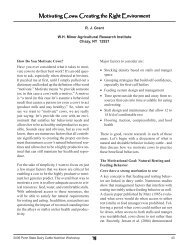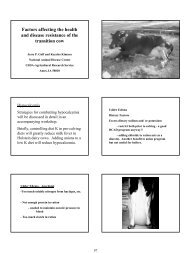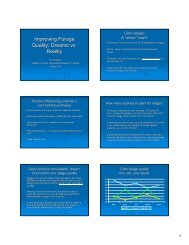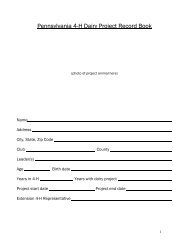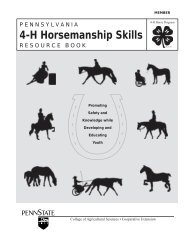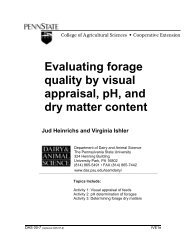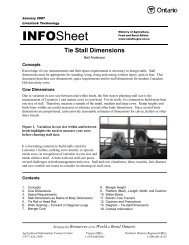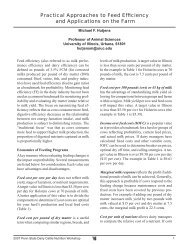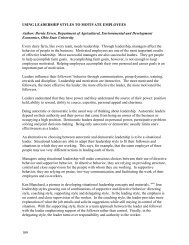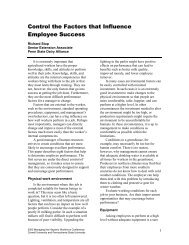DETERMINING THE MINERAL REQUIREMENT OF DAIRY CATTLE
DETERMINING THE MINERAL REQUIREMENT OF DAIRY CATTLE
DETERMINING THE MINERAL REQUIREMENT OF DAIRY CATTLE
Create successful ePaper yourself
Turn your PDF publications into a flip-book with our unique Google optimized e-Paper software.
normal rumen pH. Mg sulfate and Mg Cl are much more soluble and available for<br />
absorption. !!<br />
Because K can have such a large effect on Mg absorption the coefficient for<br />
absorption of Mg should be decreased when high K is present in the diet. Greene et al<br />
(1983) working with sheep found that the apparent absorption of Mg decreased linearly by<br />
5.7% for every percentage increase in dietary K above 0.6% K.<br />
Sodium (Na)<br />
Deficiency symptoms<br />
Plants contain only small amounts of Na, leaving herbivores at risk of becoming Na<br />
deficient if salt is not added to the diet. Na deficient animals develop an intense craving for<br />
salt leading to pica with licking and chewing of various objects. Prolonged Na deficiency<br />
leads to an unthrifty animal with rough hair coat, haggard appearance, and poor growth<br />
and productivity. Cows will produce less milk.<br />
Toxicity symptoms<br />
Animals can tolerate very high levels of dietary salt if water is provided and the kidneys<br />
are functioning. They simply excrete the excess via the kidneys. High dietary salt (Na Cl)<br />
will reduce feed intake in animals. Grain intake in ad lib fed cattle can be limited by<br />
including 4-5% salt into the ration.<br />
Chloride (Cl)<br />
Dietary Cl is absorbed with at least 80% and closer to 100% efficiency. The kidneys<br />
excrete Cl that is in excess of that needed to produce stomach acid and intestinal<br />
secretions, sweat, and to maintain acid-base balance in the animal. Often Cl anions<br />
accompany the movement of Na cations.<br />
Deficiency symptoms<br />
Cl deficiency can result in metabolic alkalosis and hypovolemia. Less severe<br />
deficiency can cause lethargy and poor performance. It rarely occurs if salt is fed. If salt is<br />
not fed Na deficiency will generally occur long before Cl deficiency.<br />
Toxicity symptoms<br />
Feeding high amounts of Cl that are unaccompanied by Na or K (for example, feeding<br />
ammonium Cl or Ca Cl) will induce metabolic acidosis which can be life threatening. Fed in<br />
high amounts it can have the same toxic effects as Na in terms of increasing the osmolarity<br />
of the blood and cerebrospinal fluids.<br />
Potassium (K)<br />
Nearly all of the dietary K is absorbed. The kidneys excrete the excess absorbed K.<br />
High blood K concentration (hyperkalemia) can directly stimulate secretion of aldosterone<br />
by the adrenal enhancing renal secretion of K.<br />
Dietary K can enter the extracellular fluids very rapidly following a meal, while the<br />
kidney will take several hours to excrete the excess K. Gastrointestinal secretion of K can<br />
work with the kidneys to help prevent hyperkalemia but it is the intracellular uptake of K<br />
following a meal that helps buffer blood K concentration. This intracellular uptake of K is<br />
mediated by insulin, which is secreted in response to hyperglycemia induced by a meal or<br />
in response to elevated plasma K concentration. Insulin increases the activity of the Na-K<br />
ATPase pump, particularly in the liver and skeletal muscle increasing uptake of K by these<br />
42




